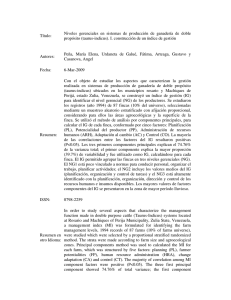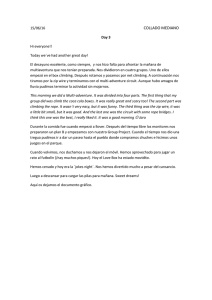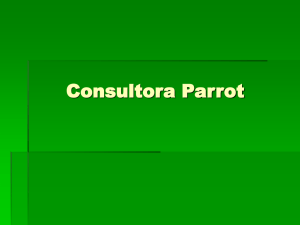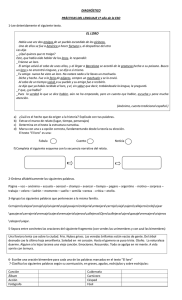ASPECTOS RELACIONADOS CON LA HISTORIA
Anuncio
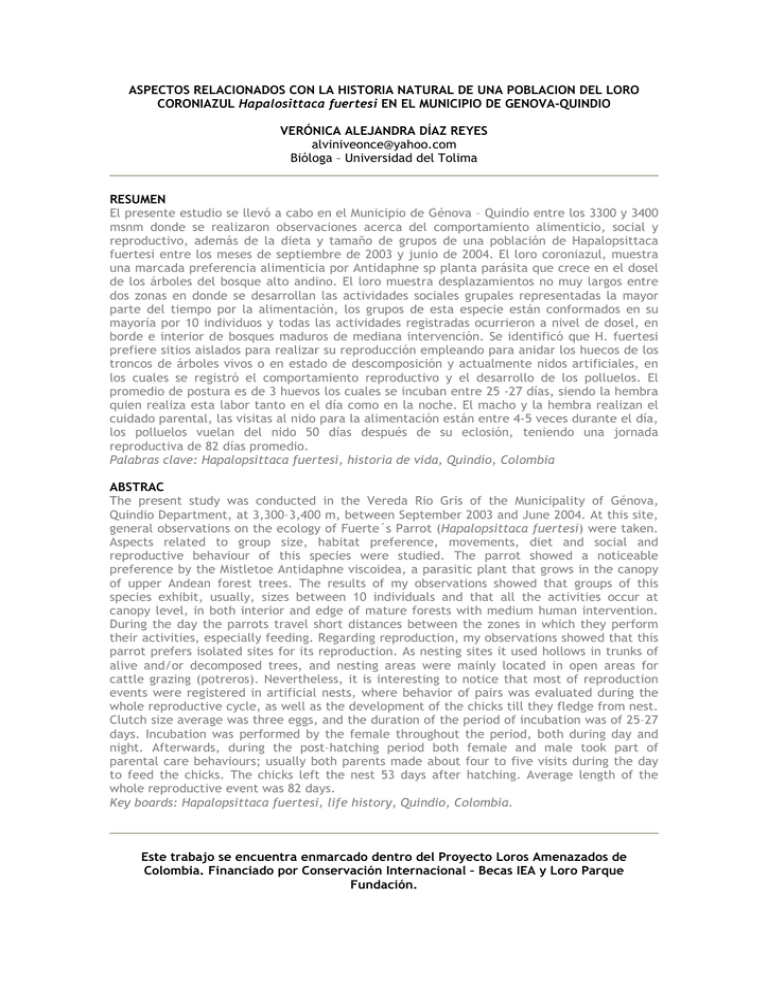
ASPECTOS RELACIONADOS CON LA HISTORIA NATURAL DE UNA POBLACION DEL LORO CORONIAZUL Hapalosittaca fuertesi EN EL MUNICIPIO DE GENOVA-QUINDIO VERÓNICA ALEJANDRA DÍAZ REYES [email protected] Bióloga – Universidad del Tolima RESUMEN El presente estudio se llevó a cabo en el Municipio de Génova – Quindío entre los 3300 y 3400 msnm donde se realizaron observaciones acerca del comportamiento alimenticio, social y reproductivo, además de la dieta y tamaño de grupos de una población de Hapalopsittaca fuertesi entre los meses de septiembre de 2003 y junio de 2004. El loro coroniazul, muestra una marcada preferencia alimenticia por Antidaphne sp planta parásita que crece en el dosel de los árboles del bosque alto andino. El loro muestra desplazamientos no muy largos entre dos zonas en donde se desarrollan las actividades sociales grupales representadas la mayor parte del tiempo por la alimentación, los grupos de esta especie están conformados en su mayoría por 10 individuos y todas las actividades registradas ocurrieron a nivel de dosel, en borde e interior de bosques maduros de mediana intervención. Se identificó que H. fuertesi prefiere sitios aislados para realizar su reproducción empleando para anidar los huecos de los troncos de árboles vivos o en estado de descomposición y actualmente nidos artificiales, en los cuales se registró el comportamiento reproductivo y el desarrollo de los polluelos. El promedio de postura es de 3 huevos los cuales se incuban entre 25 -27 días, siendo la hembra quien realiza esta labor tanto en el día como en la noche. El macho y la hembra realizan el cuidado parental, las visitas al nido para la alimentación están entre 4-5 veces durante el día, los polluelos vuelan del nido 50 días después de su eclosión, teniendo una jornada reproductiva de 82 días promedio. Palabras clave: Hapalopsittaca fuertesi, historia de vida, Quindío, Colombia ABSTRAC The present study was conducted in the Vereda Rio Gris of the Municipality of Génova, Quindio Department, at 3,300–3,400 m, between September 2003 and June 2004. At this site, general observations on the ecology of Fuerte´s Parrot (Hapalopsittaca fuertesi) were taken. Aspects related to group size, habitat preference, movements, diet and social and reproductive behaviour of this species were studied. The parrot showed a noticeable preference by the Mistletoe Antidaphne viscoidea, a parasitic plant that grows in the canopy of upper Andean forest trees. The results of my observations showed that groups of this species exhibit, usually, sizes between 10 individuals and that all the activities occur at canopy level, in both interior and edge of mature forests with medium human intervention. During the day the parrots travel short distances between the zones in which they perform their activities, especially feeding. Regarding reproduction, my observations showed that this parrot prefers isolated sites for its reproduction. As nesting sites it used hollows in trunks of alive and/or decomposed trees, and nesting areas were mainly located in open areas for cattle grazing (potreros). Nevertheless, it is interesting to notice that most of reproduction events were registered in artificial nests, where behavior of pairs was evaluated during the whole reproductive cycle, as well as the development of the chicks till they fledge from nest. Clutch size average was three eggs, and the duration of the period of incubation was of 25–27 days. Incubation was performed by the female throughout the period, both during day and night. Afterwards, during the post–hatching period both female and male took part of parental care behaviours; usually both parents made about four to five visits during the day to feed the chicks. The chicks left the nest 53 days after hatching. Average length of the whole reproductive event was 82 days. Key boards: Hapalopsittaca fuertesi, life history, Quindio, Colombia. Este trabajo se encuentra enmarcado dentro del Proyecto Loros Amenazados de Colombia. Financiado por Conservación Internacional – Becas IEA y Loro Parque Fundación.
